
Hoarding, or the excessive collection of items regardless of their value, can lead to hazardous living conditions and a decreased quality of life. Treatment may be necessary and can be challenging for both the individual with hoarding tendencies and their loved ones.
There is no universal treatment for hoarding, but there are options available for those seeking help. As a hoarding cleanup company, we work with professionals to provide help and support to individuals dealing with Hoarding Disorder. In this blog post, we’ll share some of the most effective hoarding treatment options.
Disclaimer: We do not hold professional licenses in the field of psychology. Please seek advice from a licensed professional when dealing with hoarding disorder.
CBT is a type of talk therapy that aims to help individuals recognize and change negative thought patterns. Through this method, individuals can identify and process the underlying emotions and behaviors that contribute to hoarding. CBT also helps individuals develop coping skills for managing future urges to hoard.

Motivational interviewing helps individuals become more aware of the negative impact hoarding has on their lives and relationships. Experts suggest that through empathetic listening and reflection, individuals can become more motivated to make changes.
There are a variety of support groups available for individuals dealing with hoarding disorder. Support groups can provide a sense of community, understanding, and accountability. Group members can share experiences and encourage one another to make progress toward their goals.
Find a Support Group in your area: International OCD Foundation - Hoarding Support Groups
Sometimes, specific symptoms that co-occur with hoarding are addressed using medication. These symptoms may include depression, anxiety, or obsessive-compulsive disorder (OCD). However, medication alone is not recommended for Hoarding Disorder.
Hoarding Disorder can affect people of all ages, races, and backgrounds. People often excessively collect and store items that are usually useless or unnecessary. Hoarding behavior can range from mild to severe and can have a significant impact on an individual's daily life. There are several reasons why someone may develop hoarding tendencies:
Hoarding Disorder can have severe consequences, both for the individual and their loved ones. One of the most significant challenges is the potential for health and safety hazards.
Recognizing and treating Hoarding Disorder can be challenging, but it is possible with the right resources and support. Cognitive Behavioral Therapy, motivational interviewing, support groups, and medication are all viable hoarding treatment options. Each individual should discuss these options with a licensed professional to determine the best course of action.
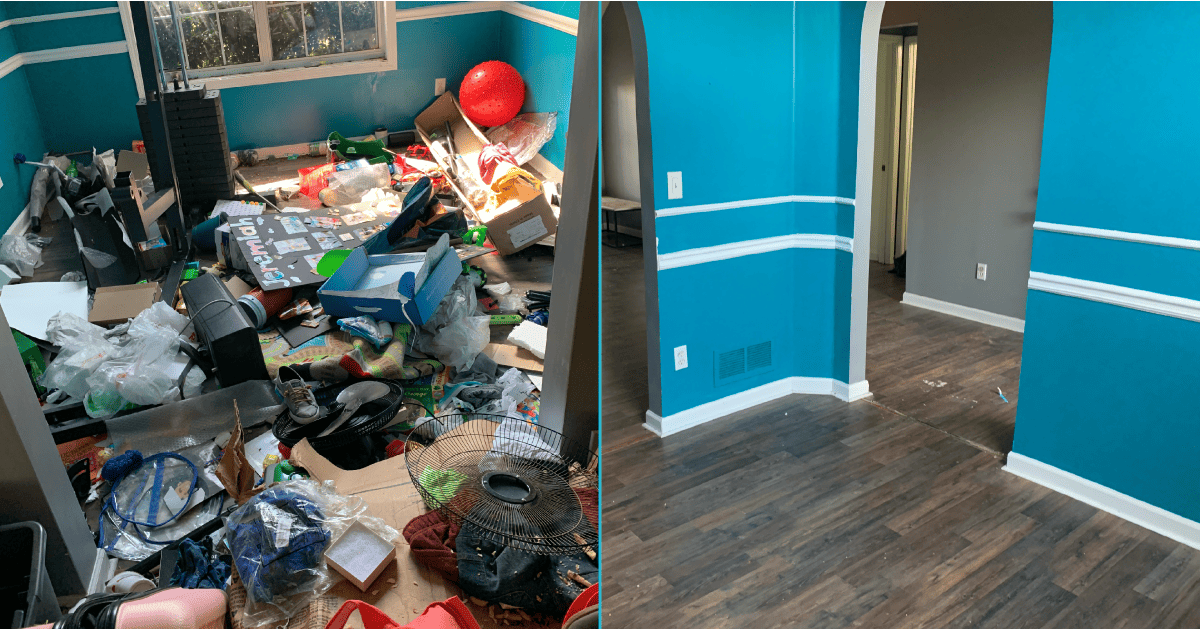
At Bio-One of Marion County, our team is trained to carefully, respectfully, and understandingly handle the delicate nature of hoarding cleanup. We use state-of-the-art equipment and techniques to safely remove clutter and biohazards from the affected area, restoring it to a safe and habitable condition. Feel free to reach out to us for immediate assistance!
Bio-One of Marion County is a locally owned and operated biohazard and hoarding cleaning company serving Indianapolis and the surrounding areas. We specialize in all types of extreme cleaning, including blood and bodily fluids, decomposition/undiscovered death, crime scene, suicide cleanup, tear gas, feces/urine, rodent droppings, sewage backups, hoarding, gross filth, virus/bacteria disinfection and odor removal. Helping people get their lives back in order is our #1 priority.
Bio-One of Marion County is here to help you 24/7, 365 days a year! Call (317) 499-0614, and you'll speak directly to one of us when you call; there is never an answering service. We'll treat you like a person with the compassion and respect that you deserve.

There are varied reasons people hang on to things they don’t need based on their circumstances or deeper-lying struggles. A cluttered home—even one that would qualify as a Level 5 situation—doesn’t stem from laziness or lack of willpower.
More often than not, a cluttered home is the result of a difficult-to-control situation, which is part of normal life.
What’s the source of your clutter? Following, are a few factors that may be contributing to your at-home clutter:

Having children can bring an abundance of joy, but also plenty of clutter.
Baby gear that is only used for a short period of time, rapidly changing clothes sizes, and piles of toys accumulate quickly.
It doesn’t end with the baby phase, though. As all guardians know, older kids and teens bring their own messes into the home.
Food-related messes combined with sleep deprivation can make it difficult to keep up with housework.
With children leaving clutter everywhere and food-related messes needing immediate care, it can be difficult to keep up with housework. Especially when you consider the sleep deprivation that also comes with kids.
Between art and science projects on the counter and smelly gym bags and laundry
left around the house, things can get (or stay!) messy.
It doesn’t help that children aren’t well-known for cleaning up after themselves!

As adults age, they may struggle to keep up with their housework.
Think of all the reaching and bending over. Consider all the hard scrubbing. With health issues, simple cleaning tasks take much longer to accomplish, if it can still be done.
Decreased mobility and increased health issues can make cleaning overwhelming or even impossible.
In addition, it can be difficult to let go of possessions accumulated over a lifetime.
Anxiety can make it difficult to throw away possessions.
People with anxiety may hold on to items in excess in case of a feared emergency or indecision about what to do with items.
Finding the motivation to clean and declutter is often a struggle for someone suffering from depression.
The stress of an out-of-control home situation (whether it’s actually out of control
or simply perceived to be) can create a negative feedback loop.
For example, maybe you’re struggling with depression and lack the motivation to do the dishes. This means the dishes quickly pile up and within a week or two every surface in your kitchen could be covered in dirty dishes.
Now, you’re facing an overwhelming mess that can make you feel even worse—piling on exhaustion, guilt, and shame—and making you even less likely to find the motivation to clean up.
This cycle can leave those struggling with depression feeling more overwhelmed and less able to approach their home situation.
Individuals with ADHD often have intense, passionate interests and may accumulate items related to that interest. In addition, it can be difficult for a person with ADHD to create and stay focused on a plan for a big cleaning project. Anytime there are multiple steps involved, it’s easy for people with ADHD to get distracted.
Obsessive-compulsive disorder is characterized by obsessive, intrusive thoughts and compulsive behaviors. People with OCD sometimes deal with anxieties and emergencies by compulsively buying items. They may have obsessions about running out of essential items or a buying ritual that is difficult to break out of.

Trauma can be a trigger for accumulating clutter. If someone grew up without:
They may feel driven to hold onto things rather than throw them away when they are no longer needed. Research shows that childhood emotional abuse and physical neglect in particular predict higher levels of hoarding symptoms.
People who have experienced loss may also accumulate possessions to soothe the ache of missing their loved one. Buying new things triggers a brief dopamine high, bringing temporary emotional relief.

If you grew up in a home where clutter was common, you are more likely to show these behaviors yourself. You may have a genetic disposition toward it through related diagnoses like anxiety or depression. You may also be more used to an environment where clutter, mess, and even the higher levels of hoarding are the norm.

No matter the reason clutter starts, it’s normal to feel overwhelmed and stressed by the situation. Home maintenance is a big task under any conditions. Certain factors can make the situation feel impossible such as:
Stress can lead to disorganized homes, and disorganized homes can increase stress. Natalie Christine Dattilo, PhD, clinical health psychologist and instructor of psychiatry at Harvard Medical School, calls it a chicken-or-egg dilemma.

“Recent studies have shown that clutter in our homes is associated with higher cortisol levels [our stress hormone], but it’s still unclear which comes first,” says Dattilo.
“Is it that when we are under stress, our ability to maintain a well-organized home becomes impaired? Or when our home is in disarray, does that make us feel more stressed, overwhelmed, and anxious?”
Regardless of the root of the issue, there is a way out. Resources are available to help you deal with your home situation. Bio-One can help! Our services can help ease your stress. For more information on how we can help you with your clutter call (317) 499-0614.
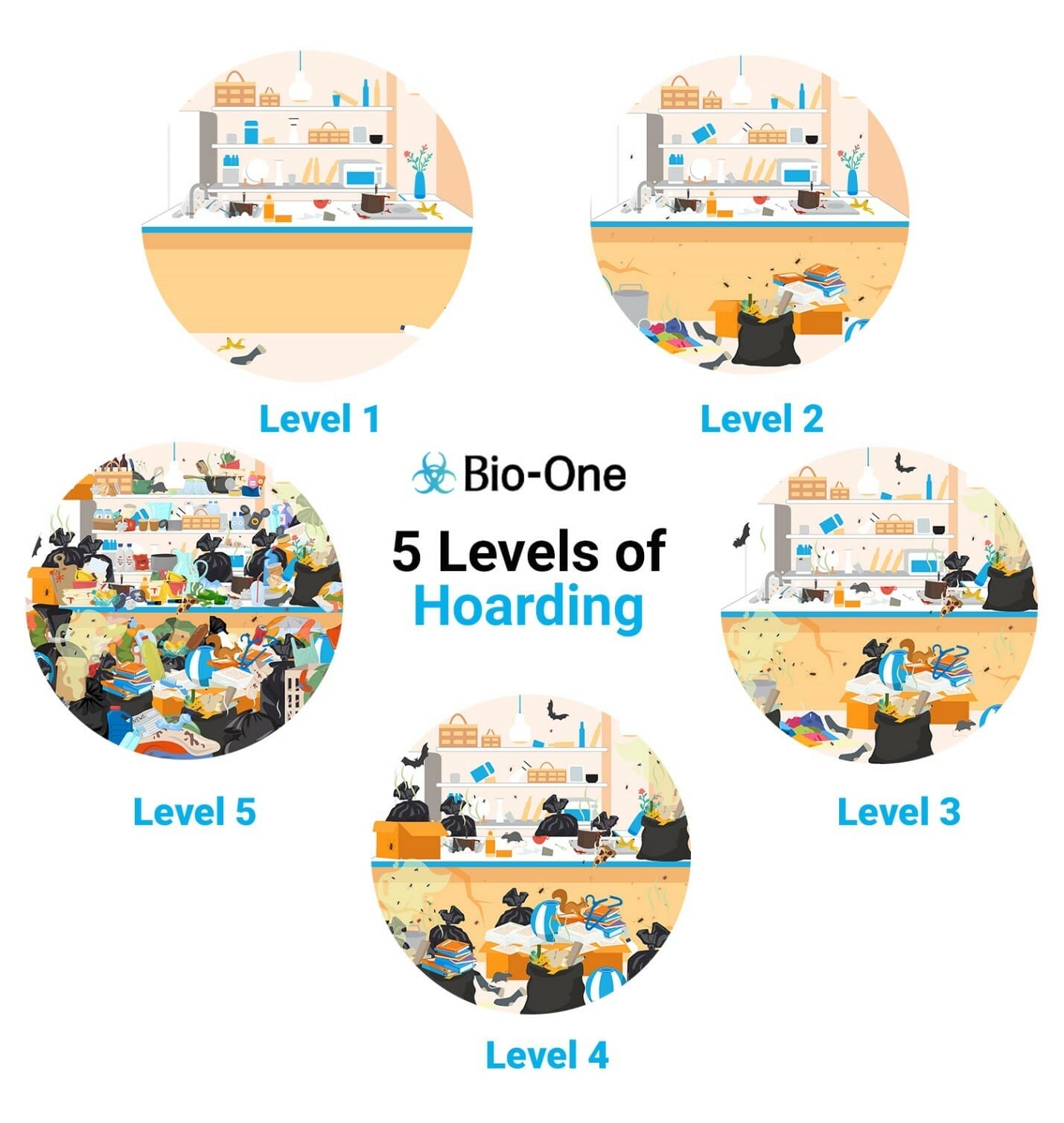
The word “hoarding” probably evokes a particular image, made more common by shows like Hoarders that highlight extreme examples. In reality, not all hoarders have rooms full of items piled high to the ceiling.
The Institute for Challenging Disorganization (now, there’s a relatable title!) has classified hoarding behavior into five levels on their Clutter-Hoarding Scale.Level 1 Hoarding
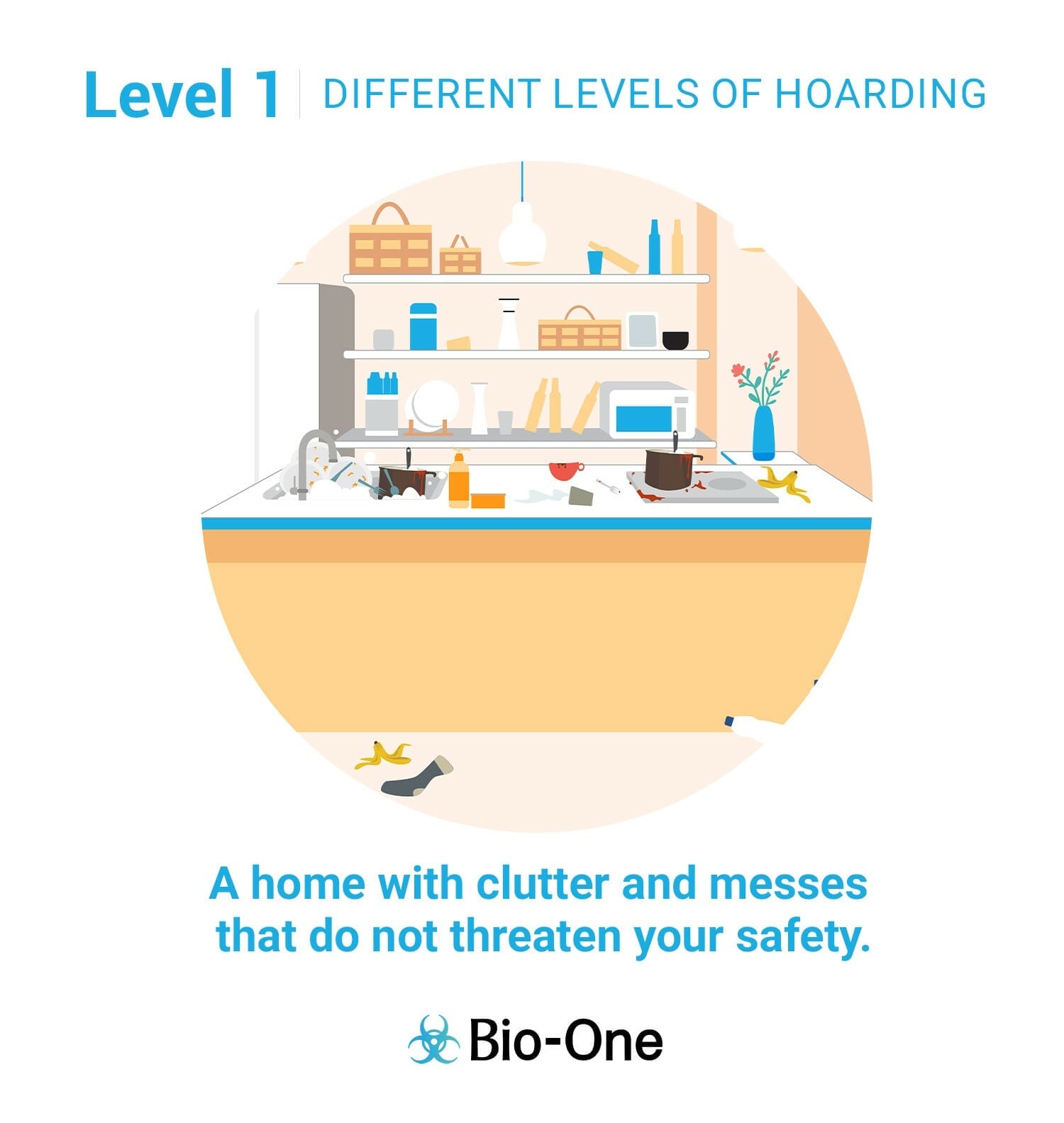
At Level 1, a home is not pristine, but the space is still easily accessible and sanitary. There is clutter, but no concern for safety. Most, if not all of us, have been in Level 1. Many people spend most of their time in this stage.
Here are the defining characteristics of this level:

At Level 2, the home is still very livable, but there’s more evidence of disarray. The home is in need of cleaning and may be starting to overwhelm the residents. The hygiene level isn’t optimal.
Most of us bounce between Level 1 and Level 2. However, here are the more defining characteristics of Level 2:

Level 3 is considered the turning point between manageable household disorganization and a more serious issue. Level 3 homes show extreme disorganization and indicate hoarding behavior.
Here are the defining characteristics of this level:
Level 3 households should consider hiring outside help. Although, it’s still possible to get it under control with a concerted effort from the whole family

At Level 4, the home shows excessive clutter.Those living in Level 4 conditions need professional help. At this level, part of getting help includes professional cleaning to transform the house into a safe, hygienic space where people can thrive. Mental health counselors and social workers may also step in to help residents change their habits.
Here are the defining characteristics of this level:

Level 5 is the highest level of hoarding behavior. Level 5 homes are alarmingly hazardous.
They require professionals with safety equipment and training to clean.
Here are the defining characteristics of this level:
If you or someone you know is struggling with these levels of hoarding we are here to help.
You can find more information at https://bioonemarioncounty.com/ or contact us at (317) 499-0614
Clutter is an everyday occurrence and there comes a point when we all need to clean up our messes. Leave things long enough, and we all start to fall into one of the 5 levels of hoarding.
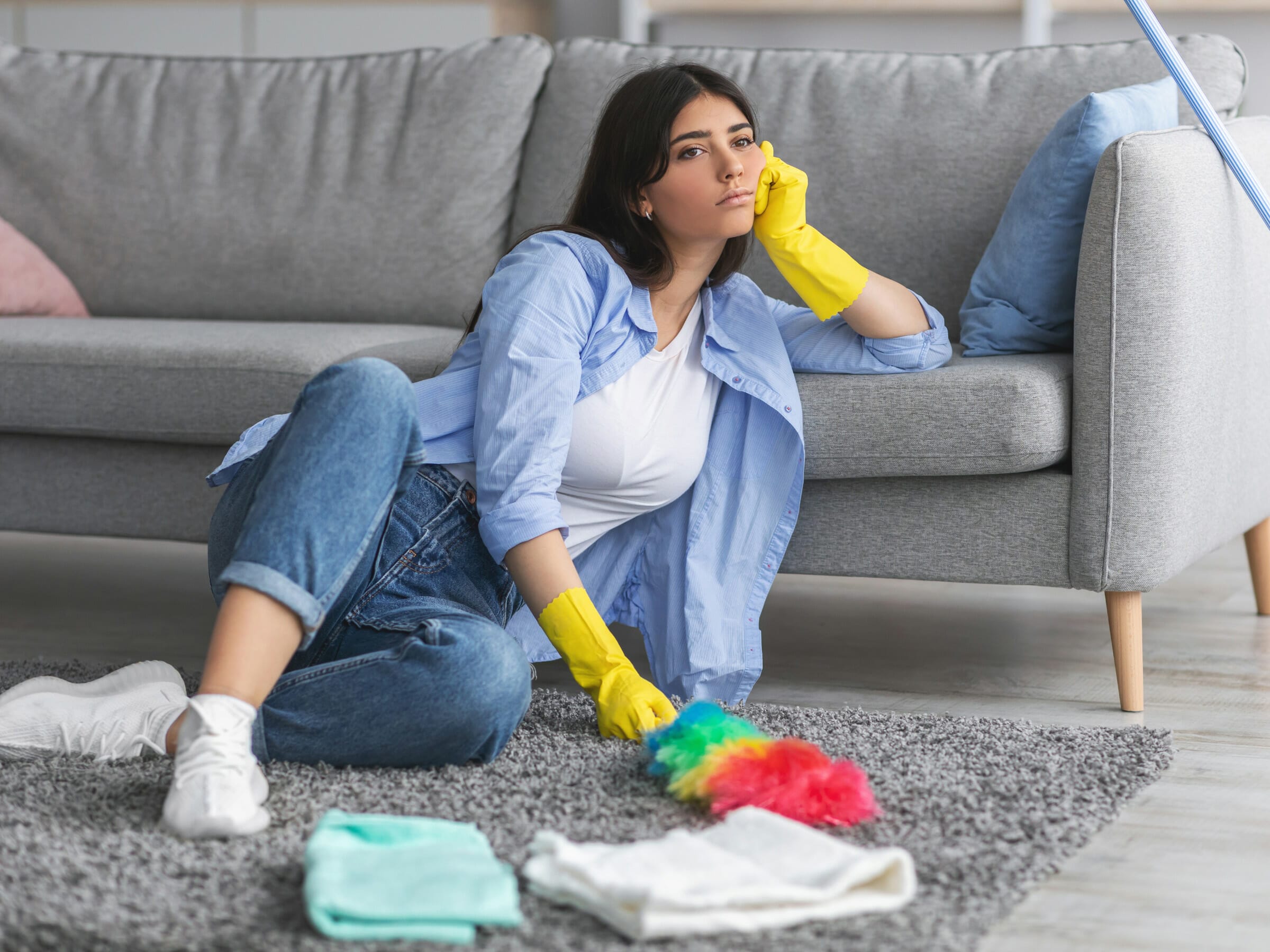
But what are the 5 levels of hoarding?
What moves a messy room from Level 2 to Level 3?
Understanding the hoarding level of your space can help you prioritize which messes are one-person tasks and which may need some help from a back-up team.
Let’s walk through each level of the Institute for Challenging Disorganization’s Clutter-Hoarding Scale to better understand just how normal hoarding is.
There’s no doubt that many of us would like our homes to look as pristine as a real estate listing ad. But life’s hectic! With busy work and family schedules, numerous responsibilities and obligations, and competing priorities it’s easy to put off a small mess for later. However those moments of procrastination stack up to put our home at a Level 1.
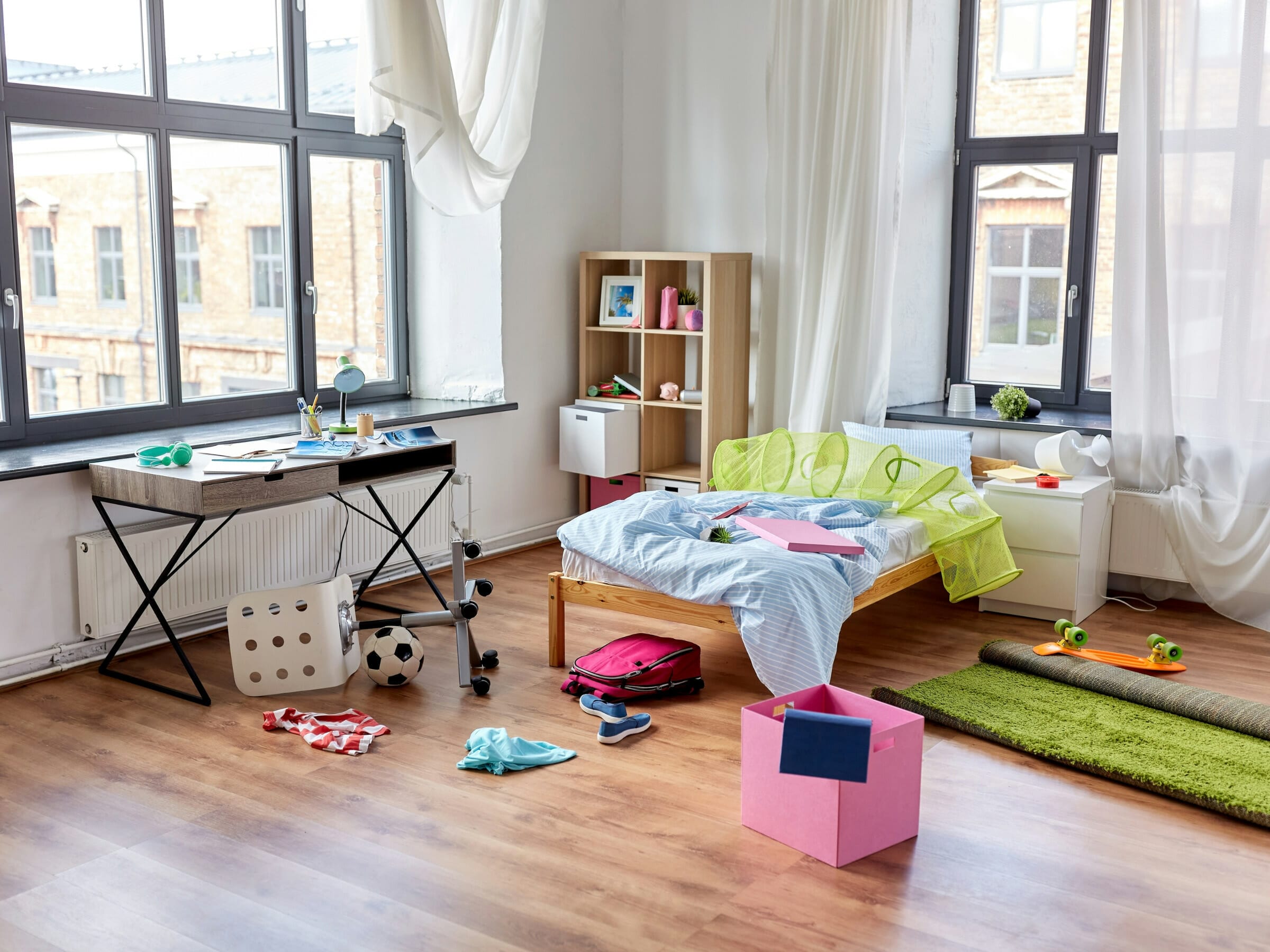
Signs of this level of hoarding include clutter and messes that do not threaten your safety:
Ok, that last one MIGHT be dangerous if you’re barefoot.
None of these messes block exits in your home, and they do not cause an immediate bad odor. If we’re honest, we can admit that all of us—at one point or another—have had our home come in on this level of the hoarding scale.
Leaving your house in this state does not necessarily affect your health.
However, it may exacerbate avoidance habits that lead to snacking and more procrastination—which might lead to more clutter, shifting you up the scale.
This is another common level of hoarding. Most of us frequently bounce between Level 1’s clutter and Level 2’s disarray.
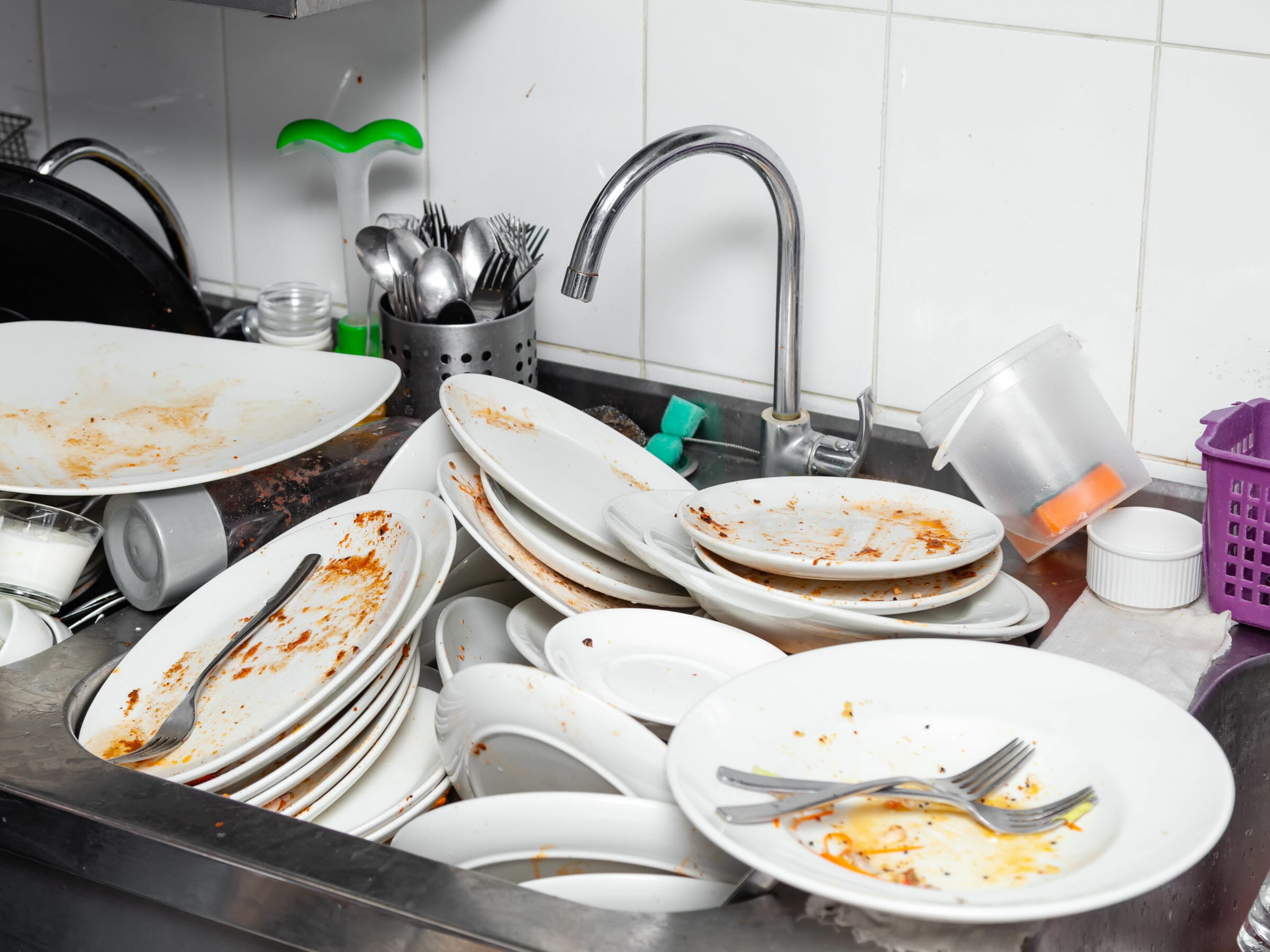
At this level, things literally begin to stack up:
At Level 2, the clutter can begin to impact a variety of areas of our lives. Some studies claim intense clutter increases our stress, makes allergies worse, and overall causes us to feel less satisfied with life.
These negative impacts are sometimes the trigger that leads to the situation getting worse.
Level 3 is where things begin to get concerning.

At this point, the mess itself may seem too daunting to tackle, and the increase in clutter results in a decline of cleanliness. There may be piles of objects obstructing multiple exits—or even a whole room used for storage instead of living.
It’s at this stage that pest infestations may become an issue. With the clutter, there are lots of places for unwelcome pests to hide and find food, and infestations of ants, lice, and cockroaches may warrant an exterminator. However, all that clutter makes it difficult for the exterminator to do a good job. Unfortunately, failing to clean up the source may set the stage for another infestation within a few weeks.
Another area of concern may be repairs needed around the home. Work may need to be done, but technicians or repair personnel may not be able to physically get to whatever needs to be fixed. This means small problems may become large ones as minor repairs are left to turn into bigger problems.
This state of things deeply impacts your ability to socialize. Messy and infested living spaces make it difficult to relax with your partner or family. Friends may prefer to outright avoid hangouts at your home. Your loved ones may be concerned about your living situation at this point.
The longer your home sits at Level 3, the higher the chance that leftover messes become long-term damage.
Hygiene and safety take a backseat in a house at Level 4. Long-term spills and messes create bad smells, and much of the house cannot be adequately used for each room’s purpose.

Those whose homes fit this category face daily irritation and inconvenience, all of it eventually leading to high repair bills, tripping hazards, and health hazards.
You may not think tripping hazards are a big deal, but falling over them certainly can be. Depending on how high the stacks are, they could even fall on you and do some damage that way.
There have been well documented cases where people have become trapped in their own home due to tripping hazards. Don’t let that be you!
Health hazards stack up in level 4 almost as quick as the clutter does. Issues like water damage that can no longer be reached lead to structural decay. Larger pests like bats or rodents may make their nests in the attic or basement and contribute to higher possibilities of disease.
A person or family living in this state may find it difficult to be comfortable doing anything.
Tackling the job to get the home back to a healthy and safe state may seem impossible on their own.
This is often what people think of when discussing hoarding behaviors. The situation may be the result of a psychological hoarding disorder or difficulty due to disability. It may have been compounded by depression or generational trauma or habits. The contributing factors are nuanced, varied, and often highly personal.
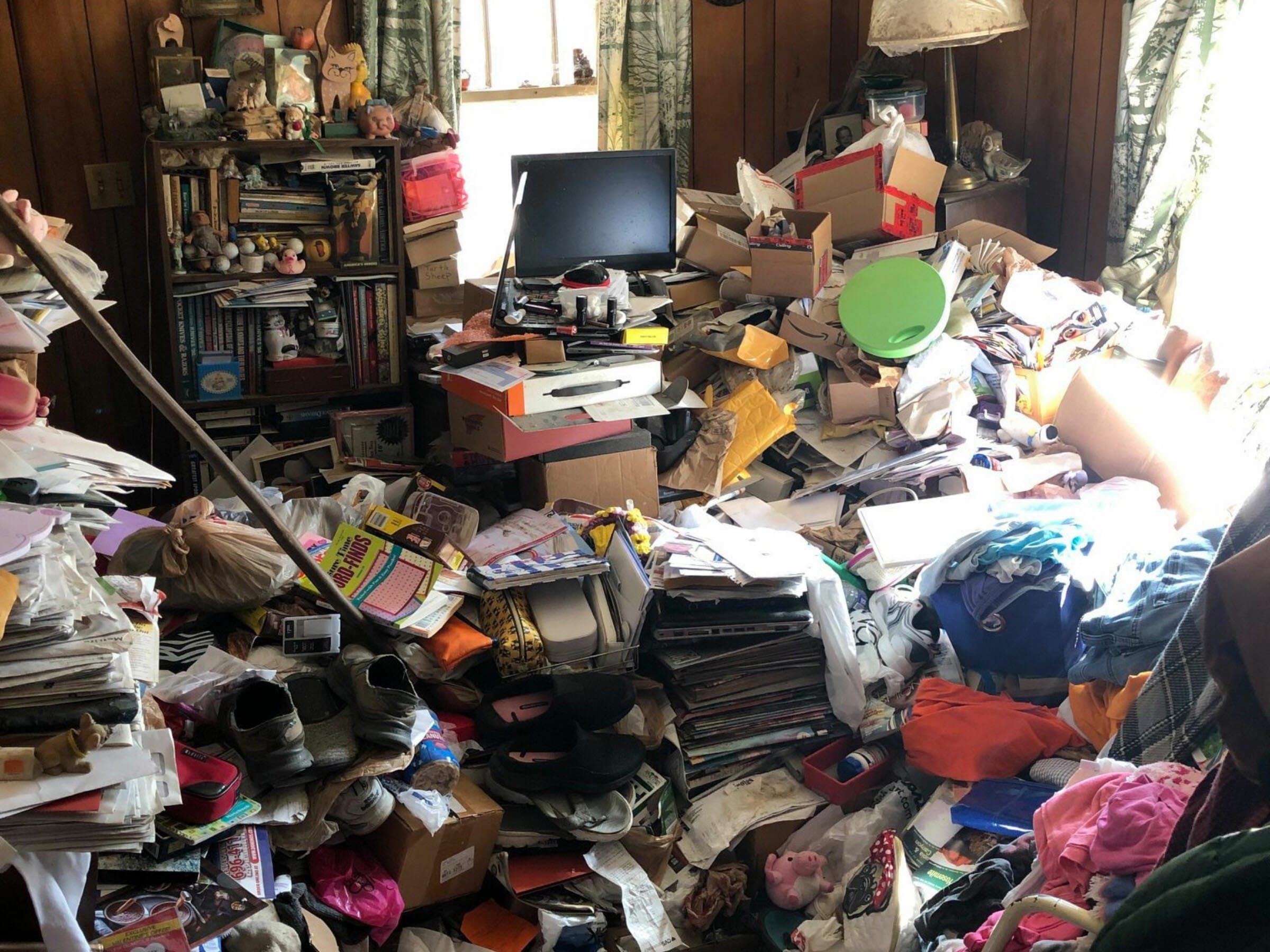
But whatever the reason, a Level 5 household is in need of serious, professional help.
Those in a Level 5 house live in outright unsafe conditions. On the daily they are coming in contact with:
Not only is it difficult to socialize with others in your home, you may find it difficult to even leave because of the sheer volume of things in the home and the blocked entryways.
Many who are at this stage find themselves disconnected from reality in a number of ways:
At this stage, the structural damage to the home is often irreparable and fire hazards begin to enter the picture.
Houses at level 5 are prone to fires because of the flammable piles of clutter. If a flame were to spark anywhere, it could easily catch something and spread from there.
Not only that, but it’s very difficult for firefighters to enter. If a fire were to start there’d be little to no way of stopping it. With so many flammable objects and no way to enter the home, all it can do is burn.
So how did your home do? Do you have an idea of where your home fits on the hoarding scale? The vast majority of us are on there somewhere, and the good news is that no matter the level your home scores, there is always help available.

After walking through all 5 levels of hoarding, it’s clear we all struggle with cleaning up the house sometimes. There’s nothing wrong with a messy house. It’s a part of normal, everyday life.
However, your health and safety are important, particularly when things advance to those higher levels. When facing a daunting clean-up, here’s quick tip for each level of hoarding:
Your home falls into one of these levels—just like everyone else’s! The next step is determining what you need to get back to a manageable Level 1.
Our team at Bio-One understands messy homes, and we’re here to offer discreet, compassionate help when you or a loved one is trying to dig out from a higher level mess. We offer affordable, professional services that include cleanup, disinfection, and decontamination.
Every job has a unique remediation plan tailored to the specific needs and goals of the client. Rest assured, wherever you may fall on the levels of hoarding, we have the experience and equipment necessary to help you.
Consult with our team today to discuss your situation and determine how much time you can save with professional help.

Thanks to multiple TV shows, I think most of us are at least aware of the term "hoarding" or "hoarders." Maybe you've seen an episode of "Hoarders" where a person's home is overtaken by clutter and filth. Although it may be easy to watch someone deal with this on TV, the reality of hoarding is not dealt with in a single one-hour episode.
Hoarding is a mental health disorder that causes those suffering to compulsively acquire and keep items that may be considered useless or unnecessary. With hoarding disorder, sometimes even just the thought of getting rid of items can cause major distress for the individual.
Bio-One has assisted in the hoarding cleanup process for thousands of people across the US who struggle with this illness. At Bio-One, we take mental health seriously because the impact of those struggles can affect so many people, not just those who are personally afflicted. What may seem like basic clutter could be the early signs of a deeper issue. These situations can be mentally and emotionally taxing for all involved, so it is sometimes necessary to call professionals for help.
At Bio-One, we take pride in helping others and treating them with the utmost respect, no matter the nature of the scene. We understand how overwhelming and daunting a major cleanup or remediation can be, which is why we are here to help. If you know someone who has hoarding tendencies, there are mental health professionals who specialize in diagnosing and treating hoarding disorders.
Resources:
International OCD Foundation
American Psychiatric Foundation
Bio-One of Marion County is a locally owned and operated biohazard and hoarding cleaning company serving Indianapolis and surrounding areas. We specialize in blood, bodily fluid, and feces removal, rodent droppings cleaning, sewage cleanup, hoarding, and pet hoarding cleaning, gross filth cleanup, and odor removal services. Helping people who are faced with difficult situations to get their surroundings and lives back in order is our #1 priority.
Bio-One is here to help you 24/7, 365 days a year! Call (317) 499-0614, and you'll speak directly to one of us when you call; there is never an answering service. We'll treat you like a person with the compassion and respect that you deserve.
Clutter and hoarding can create a perfect environment for pests to thrive, making it difficult to control or eliminate an infestation. If you or someone you know is facing this problem, it's essential to take quick action to address the situation and prevent it from getting worse. Here's are the 4 steps you should follow:
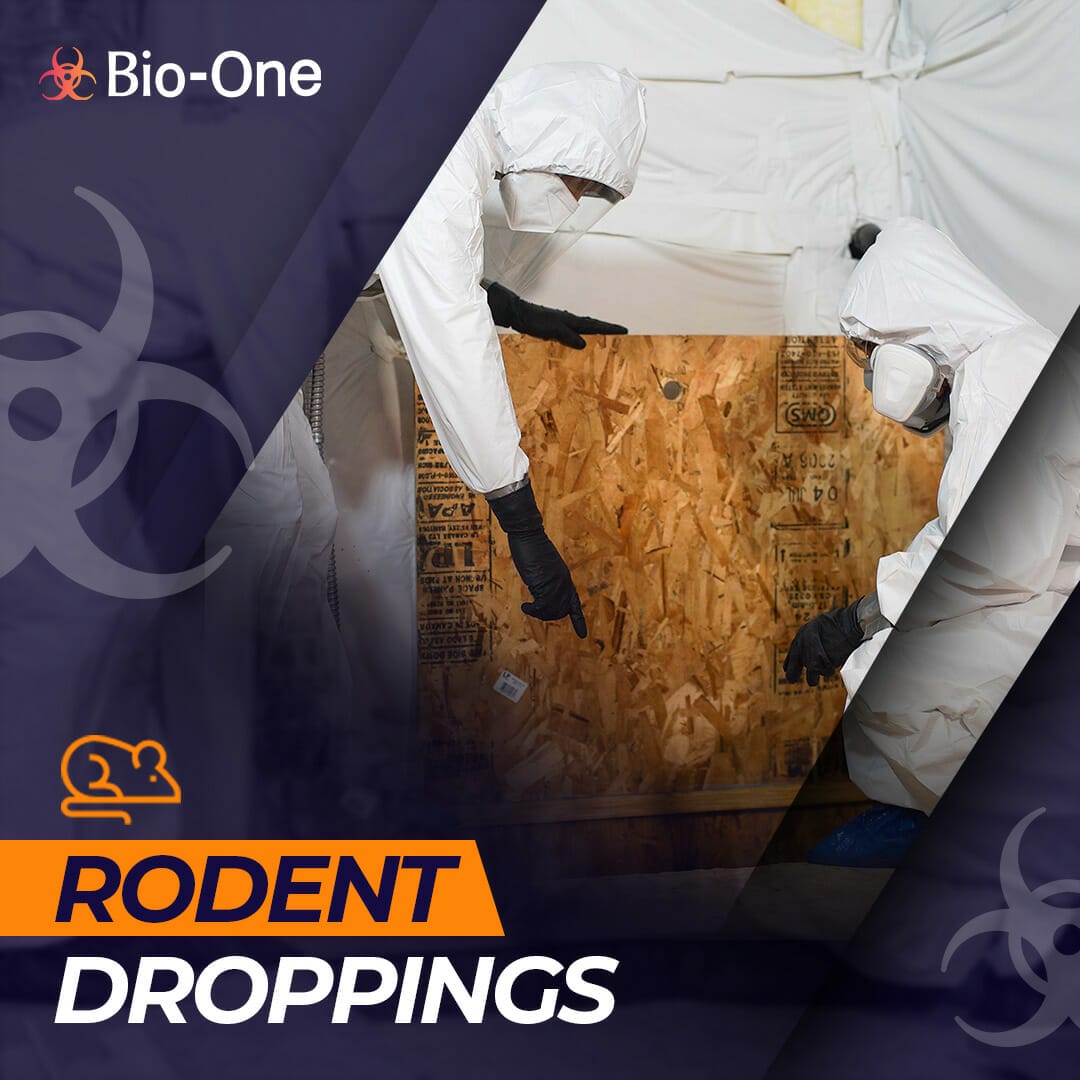
The first step is to call a professional pest control company to assess the infestation and provide the best solution. They will be able to identify the type of pest and the extent of the infestation and recommend the appropriate treatment.
Once the pests have been identified, remove any cluttered items harboring the pests, including cardboard boxes, old magazines, and other items that provide shelter and food sources. Any contaminated items should be bagged and disposed of immediately. We recommend that you use proper protective equipment during this stage. If this feels overwhelming, you can always call a biohazard company to help. Their technicians know how to identify areas that may be contaminated and use specialized techniques and equipment to remove any hazardous materials.
Because pest infestations can pose serious health risks, it is crucial to clean and disinfect any contaminated items to prevent the spread of disease-causing pathogens after decluttering. Use a strong disinfectant and pay extra attention to areas that may have been contaminated, such as cupboards, drawers, and other hidden spaces. This will help remove any remaining pests and their eggs and eliminate any unpleasant odors that may have developed.
If you want the peace of mind that the cleaning and disinfection are done correctly, you can hire a biohazard company. They will take all necessary precautions to protect themselves and others from exposure to hazardous materials during the cleaning and disinfecting process. This includes wearing personal protective equipment (PPE) and following proper decontamination protocols. Biohazard companies use specialized disinfectants that are specifically designed to kill disease-causing pathogens. These disinfectants are highly effective and can help prevent the spread of illness.
To prevent future pest infestations, it's essential to implement measures to keep your home and surroundings clean and tidy. This includes regular cleaning, proper storage of food, and sealing any cracks or crevices where pests may enter.
Hiring a biohazard company after a pest infestation is crucial to ensure the proper cleaning and disinfection of contaminated items. Biohazard companies have the expertise, equipment, and processes to effectively clean and disinfect your home or business, ensuring that it is safe for you and others. While hiring a biohazard company may seem expensive, it is often the most cost-effective solution in the long run. This is because proper cleaning and disinfection will prevent the spread of illness and potential lawsuits, saving you money in the long run.
Call us 24/7 at (317) 499-0614 for a free estimate, or find out more about hoarding remediation services at BioOneMarionCounty.com/hoarding-cleanup.
Learn more about the biohazard services we provide to residents in Indianapolis and surrounding areas at BioOneMarionCounty.com/services

The phenomenon of hoarding has become increasingly prevalent in recent years. According to the National Alliance on Mental Illness (NAMI) in Massachusetts, an estimated 5% of the population in the United States alone suffers from the disorder. Hoarding is a psychological disorder that can lead to extreme accumulation of items, often creating hazardous living conditions. This can lead to an unsafe environment for the hoarder and any visitors.
Hoarding can pose a serious safety risk. Piles of belongings can create a fire hazard, and the sheer amount of clutter can make it challenging to move around the home safely. When you enlist a hoarding cleaning service like Bio-One of Marion County, they can help restore your home's safety by removing the clutter and ensuring all pathways are clear.
When a hoarding situation arises, it is essential to enlist the help of a professional biohazard cleaning company like Bio-One of Marion County to ensure the safety of all involved. We specialize in removing hazardous materials, such as human and medical waste, and other items that may have been exposed to various infectious diseases or viruses. Our certified technicians use specialized equipment, such as HEPA filters, to safely and effectively remove these items from home.
Call us 24/7 at (317) 499-0614 for a free estimate, or find out more about hoarding remediation services at BioOneMarionCounty.com/hoarding-cleanup.
Learn more about the biohazard services we provide to residents in Indianapolis and surrounding areas at BioOneMarionCounty.com/services

Bio-One teams across the U.S. answer calls to help their communities and remediate a variety of scenes. In our new blog series, we'd like to bring you into the Bio-One world by sharing stories of the unique and important work we do for local communities.
Here is Week 5 of our Bio-One Weekly Wrap-Up.
Chocolate Spill Makes for a Sweet Cleanup
In Scranton on March 25, Juan and Nicole Morales received a call for a "chocolate" cleanup. Assuming this was code for a sewage back-up, they rushed to scene to find a different situation entirely. Approximately 100 gallons of milk chocolate had spilled, covering asphalt outside a local business.
This is certainly the sweetest smelling job a Bio-One office has ever taken, but Nicole clarified, "That smell was nice for the first few minutes but at the end I felt sick. Good thing we had an awesome team that pushed through and got this done!"
After scraping the chocolate with a forklift and pressure washing the area, the Bio-One team received a five-star review. Well done!


Behind the Scenes with Citizen's Academy
Many Bio-One owners sign up for their local Citizen's Police Academy to acquaint themselves with the activities of their local police department. This week, Bio-One owner, Ginger Akemon, in Jacksonville, FL earned her Citizen's Police Academy certificate from the Clay County Sheriff's Office.
"Definitely a learning process. Each County has their own, my goal is to go to each county's classes. This was 10 weeks long and over an hour drive each way, but well worth it, " said Ginger.
Hoarding Transformation in Long Beach
In Long Beach, the Bio-One team has been working hard on several hoarding projects. These before and after pictures show the detail and expertise our teams bring to each job.

Bio-One teams across the U.S. answer calls to help their communities and remediate a variety of scenes. In our new blog series, we'd like to bring you into the Bio-One world by sharing stories of the unique and important work we do for local communities.
Here is Week 4 of our Bio-One Weekly Wrap-Up.
New Start for New Haven Veteran
In New Haven County, Bio-One and Junkluggers answered the call to help a veteran and his disabled wife. The couple were overwhelmed with a hoarded home and much of their furniture would need to be disposed due to biohazardous conditions. With Bio-One's Help First, Business Second motto in mind, Bio-One owner, Matthew Hill, teamed up with Junkluggers to re-furnish the home with gently used furniture at no cost to the client.
“Anytime we can give a little more to our clients, we always seize the opportunity,” said Hill. “Junkluggers has been an awesome organization with a great mission that fits nicely into what we are trying to accomplish.”

#HelpFirst for Heart-Breaking Scene
In South Carolina, Bio-One owner, Kris Elliott, was called to disinfect and clean a heart-breaking trauma scene. After hearing the family's story, he generously decided not to request payment for his services and shared their GoFundMe page on Facebook. As of March 20, Bio-One offices in North Carolina and South Carolina have contributed just under half of the total donations. This is #helpfirst at it's finest.
If you'd like to learn more about the family and donate, please visit their GoFundMe page.
Poker Run Supports Law Enforcement
Supporting local law enforcement is a 24/7 activity at Bio-One! In Tuscon, AZ, the Bio-One team participated in the South Arizona Law Enforcement Foundation (SALEF) poker run. SALEF collaborates with law enforcement to understand their greatest needs, and work with businesses in the community to raise money by presenting community events and submitting for grants.
Looks like they were gifted a beautiful day for cards, corn hole, and backing the blue.

Bio-One teams across the U.S. answer calls to help their communities and remediate a variety of scenes. In our new blog series, we'd like to bring you into the Bio-One world by sharing stories of the unique and important work we do for local communities.
Here is Week 3 of our Bio-One Weekly Wrap-Up.
Five 30 Yard Dumpsters
The team in Pensacola has been working non-stop on a two story home that required Bio-One hoarding services. Over the course of five days, they filled five 30 yard dumpsters, and found multiple antique pieces, photographs, sentimental items and cash that was promptly turned over to the client.
Look through the transformation photos on their Facebook page!
Backing the Blue in Omaha
The Bio-One team in Omaha dropped off bagels at the Omaha Police Department just before roll call, and Vanessa Urbach, the civilian crime and prevention specialist, tweeted a "Thank You" with shoutouts to Bio-One. Joining the conversation was our own Bio-One Twitter handle, Deputy Chief Ken Kanger, host of the What's Up Omaha Podcast, and a number of other officers in the department.
Kudos to the Omaha team for backing the blue!
Safety First
Before Bio-One teams can help first, we have to ensure safety for every technician on the job site. This week, Bio-One owners took part in conversations about safety. Topics ranged from preventing common injuries on the job to attending OSHA training with Bob Easter. Jared Lafferty, Bio-One owner in Gwinnett County, even took the conversation to Twitter and featured safety protocols his team uses while on the job.
We couldn't be prouder of our teams for putting safety first!